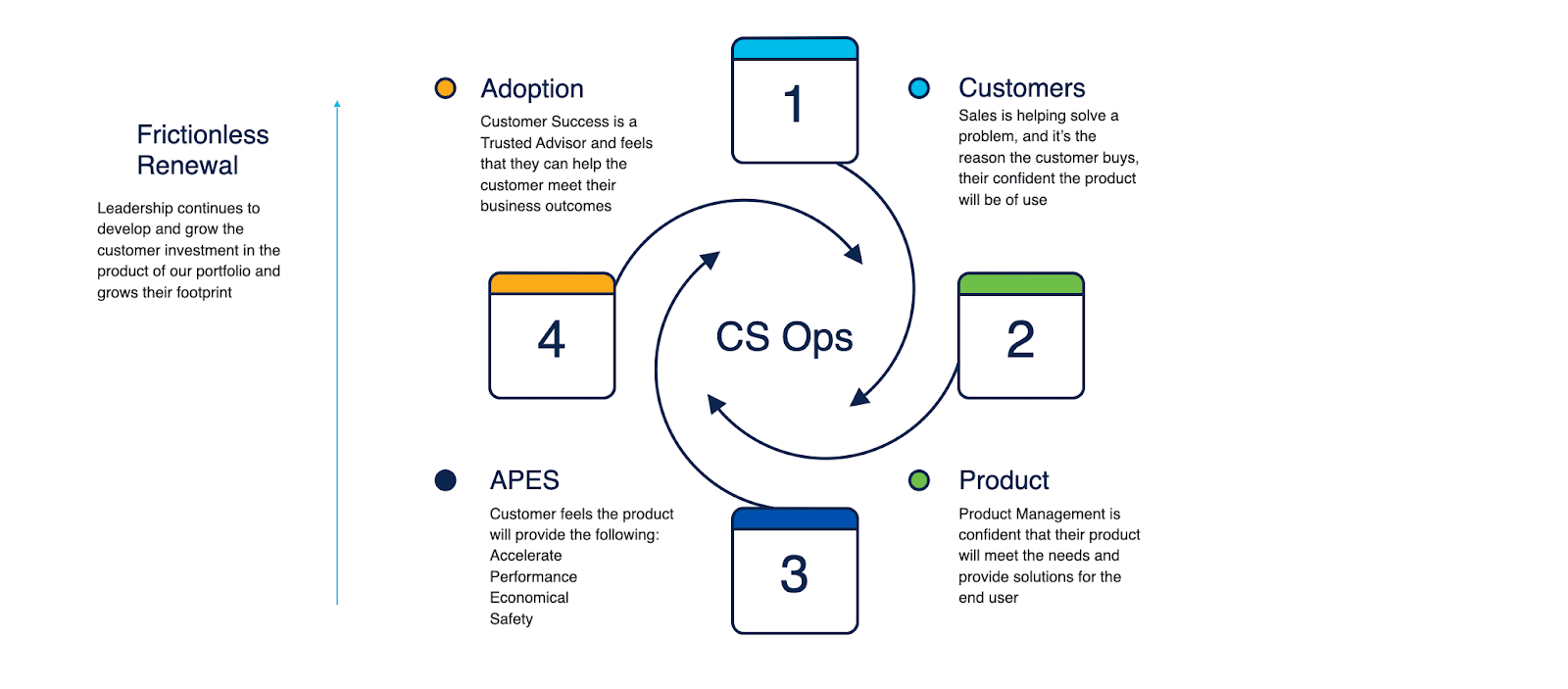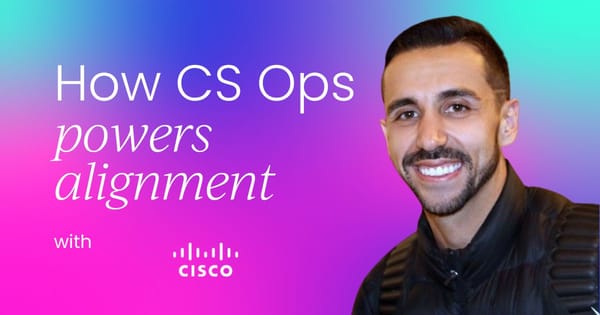Aligning business-wide initiatives and driving frictionless renewals are key goals for any customer success leader in a business that follows a recurring revenue model.
By the end of this article, we'll have unpacked frameworks, skills and mindsets to align your broader organization around customer success. Whether you're leading a small scrappy team or a large global organization, this article will provide actionable insights you can implement right away.
Let's dive in!
Transitioning to a recurring revenue model at Cisco
I've been at Cisco for a little over six years now. I was actually part of the very first founding customer success team when the company decided to make a major transition in its business model and operations.
Up until that point, Cisco had primarily been selling hardware networking equipment to its customers. However, the company wanted to switch to a software and subscription-based recurring revenue model.
Cisco reached out to me and said:
"Hey, we're trying to evolve our hardware business into more of a software and services model fueled by recurring subscription revenue. Can you help us build out a customer success team to support this transition?"
I joined Cisco and was one of the founding members of their customer success team. My role was focused on strategic initiatives, but I started out as a regular Customer Success Manager (CSM).
I spent time trying to deeply understand our customers' needs, challenges, dynamics and how we could help some of Cisco's top customers from a customer success operations perspective.
Evolving into customer success acceleration
Now, six years later, I'm still at Cisco but my role has evolved. I currently work in an area we call "CS acceleration" which sits under our main customer success organization.
I work under a great leader named Kelly Hall. In my current role, we focus on identifying and driving strategic initiatives across the customer success organization now that many of our customers are fully aligned with Cisco around our software and subscription model.
A big part of my job now is figuring out how we can accelerate the process of making sure customers are seeing value and deriving business outcomes from Cisco's solutions as quickly and seamlessly as possible.
- How can we speed up the time it takes for customers to gain concrete value once they purchase from Cisco?
- How do we start automating and optimizing our processes to ensure customers achieve success fast?
Those are some of the key questions we're tackling under the CS acceleration umbrella.
Core customer success skills and mindsets
I want to focus on sharing some insights both on the tactical "what" skills that are important for CSMs as well as some of the broader "how" skills and strategies that can really move the needle when it comes to aligning your organization around customer success.
Lean in by facing your fears
A few years ago, I attended a seminar in Salt Lake City with a good friend of mine who is one of the top cognitive behavioral therapists in the world. He was teaching about strategies for overcoming fear, uncertainty, and inertia.
He said that one of the best ways to overcome fear or anxiety is to simply lean in and directly do the thing that scares you the most. Don't hesitate or overthink it - just go for it. As part of the seminar, he had us go out into the streets of Salt Lake City and actively find opportunities to face our fears head-on.
At the time, one of my biggest personal fears was dancing in public. I've always loved dancing, but the thought of randomly dancing publicly really terrified me for some reason. So my friend told me to go dance publicly to face the fear.
I went over to a busy street corner, feeling totally awkward and scared at first. I started shaking my hips a little, trying to work up the nerve. People were staring and commenting "What's that guy doing?" I could feel the fear rising up as my cheeks flushed red.
But then I remembered my friend's advice - lean in and connect. These were strangers I'd never see again, so I just went for it. I totally let loose, dancing my heart out to the music in my head. Something interesting happened - I started having fun with it and even making connections, and interacting with the people watching me dance.
I tell this story because it relates directly to a core customer success skill - the ability to lean in. At Cisco, we even have a framework we call "lean-in" to describe how CSMs can drive value through alignment.
I want you to imagine you have the ability to lean in and connect with customers without hesitation or fear. How much value could you drive if you were able to lean in and proactively engage with customers, sales teams, product teams and executives across the organization?
The "lean-in" model for driving organizational alignment
This lean-in model represents the trusted framework we've developed at Cisco to enable CSMs to drive value through organizational alignment:

You've probably heard the term "CS Ops" recently in customer success circles. Customer success operations is a hot new area, similar to what social media was like 10 years ago. Everyone knew social media was important but companies were still trying to define their strategy and approach.
Many companies admit they don't yet have a strong customer success operations strategy or organizational structure in place. Oftentimes CSMs at these companies feel isolated or fragmented rather than empowered to drive alignment.
That's why frameworks like the “lean-in” model are so critical - they give customer success teams a blueprint for how to align the broader organization around customer success.
Walk through this customer lifecycle methodology and you'll see how it represents a transition in how customers initially connect with sales teams or account reps vs. longer-term engagement:
- Customers come first - they're still connecting with sales reps and account teams during initial purchases.
- Product management - PM teams are responsible for building great products that customers will see value in.
- Cross-functional CS communities - These are forums where customer success managers across different segments (high-touch, mid-market, tech experts, etc.) come together to share best practices and align on initiatives.
- CS programs - Cisco has over 18 major customer success programs and each program has an executive leader who presents to the CS communities on things like adoption analytics, churn predictors, expansion playbooks, etc. This level of organization ensures CSMs have the assets and insights they need to drive adoption and retention in a measurable way.
As customers move through these stages, your sales team also starts to see the incredible value generated by proper customer success planning and execution. This makes them hungry to understand how they can target the highest growth opportunities and forecast renewals based on the same metrics and insights customer success leverages.
This is why it becomes so important to have forecasting models and processes in place to predict and push customers towards frictionless, on-time renewal based on their actual usage, adoption and risk of churn.
A hypothetical example
Let me give you a hypothetical example:
Imagine you're at work and your Chief Technology Officer (CTO) calls you with an urgent request to create a customer success program that tightly aligns your renewal teams with frontline CSMs.
The CTO explains that the goal is to move your entire customer base towards frictionless, seamless renewals while also rapidly increasing product adoption.
Here's a bit more background information from the CTO:
"We need help urgently addressing some company-wide changes, sales restructuring, and implementing more scalable customer success solutions.
"The organization needs to improve our company-wide initiatives around reducing churn and better-serving customers' needs. This will ultimately lead to increased customer renewal rates, lower churn, and more upsell opportunities due to deeper product adoption.
"The objective is we have a customer base of 5,000 customers who all have renewals coming up in the next six months. Half of those customers are currently spending over $150,000 in annual recurring revenue with us.
"However, only about 10% of our entire 5,000 customer base are actively using and adopting our product capabilities based on analytics. We need to increase that adoption number dramatically while ensuring customers renew with us long-term."
Shortly after the call, you receive a follow-up email from the CTO with an attached Excel document containing all 5,000 customers. The email says:
"Here is the detailed customer renewal data we discussed. It should be self-explanatory, but let me know if you have any questions.
We'd love to make sure we get this kicked off and start realizing results next week. Looking forward to seeing what we can accomplish together over the next few weeks."
You eagerly open up the attached Excel file, ready to dive in and start analyzing the data. But you're quickly overwhelmed when you see this:

This probably looks familiar right? We've all had an executive or stakeholder hit us with a massive dump of data and simply say, "Build me a program/process to fix this!"
It's so easy to get overwhelmed in situations like these. But I want to share a few techniques I've learned over the years for how to approach challenging scenarios like this in a step-by-step manner.
Step-by-step techniques for tackling overwhelming problems
Know your organization's limits
I call this "level setting" with executives and stakeholders. Just like how there's no scientific law that says meetings must be 30 or 60 minutes long, you have to know your own limits in terms of bandwidth, resources, and capabilities.
Identify effective workflows and processes given your organizational constraints - don't overcommit.
Identify core value pillars
Get clear on three to five core company values or pillars you want any new program or initiative to align. This helps guide you when stakeholders ask you to magically "run effective motions across the whole company."
This is a values framework we built out at Cisco. Really, you can choose any acronym when it comes to your organization. But the first one, when we get asked things like:
- “I have 5,000 customers and we want to create a strong alignment with sales.”
- “We want to be able to increase and improve adoption.”
We start creating the specific acronyms to identify once we're asked something exactly what foundational pillar this falls under.
The “V” stands for “velocity,” having a strong alignment with sales of the point of sale.
The “A” stands for “activation.” How do we have a seamless activation process? How do we make sure that we're aligning our customer success initiatives to make sure that a customer is onboarding within a specific amount of time?
The “L” stands for “learning” that's one of my favorite ones. For example, as of today, a CSM for every program that we have has 21 specific assets that they can execute with their customer success motion.
They'll have seven success tips that they can send from a digital aspect. They'll have seven one-on-one accelerators where they can have a specific technical expert working with their customer, or they'll have webinars where they can sign their customer for these “Ask the Expert” sessions where the customer can ask live questions. And that's giving the autonomy to the CSM to be able to identify what resources they have.
The “U” stands for “utilization” on how we are measuring insights on what they're using.
And the “E” stands for “embedded”. We want to make sure that we've embedded a strong process just to make sure that the customer is looking at how they can grow their portfolio. But we want to make sure that if we ripped out the solution tomorrow, would they feel the impact on the business?
Finally, we always like to add value for ourselves within the organization. For me, that’s to simplify just to make sure that you don't overcomplicate the process.
Map values to stakeholder outcomes
With your values defined, map them to stakeholders' desired outcomes. When sales ask me for help, I talk about profitability, quota attainment, and reducing churn. For CSMs, it's enabling their performance.
As you start doing that, you'll start seeing specific motions that you can run across your organization.
Analyze the data
Let’s return to the hypothetical conversation with your CTO, where they discussed some of the customers that they wanted to run specific motions on.
"We need help urgently addressing some company-wide changes, sales restructuring, and implementing more scalable customer success solutions.
“The organization needs to improve our company-wide initiatives around reducing churn and better serving customers' needs. This will ultimately lead to increased customer renewal rates, lower churn, and more upsell opportunities due to deeper product adoption.
“The objective is we have a customer base of 5,000 customers who all have renewals coming up in the next six months. Half of those customers are currently spending over $150,000 in annual recurring revenue with us.
“However, only about 10% of our entire 5,000 customer base are actively using and adopting our product capabilities based on analytics. We need to increase that adoption number dramatically while ensuring customers renew with us long-term."
Break it down into bite-sized chunks tied to your core values:
- Velocity: Half of our customers are over $150K. The top 750 customers make up 50% of the annual contract value (ACV).
- Activation: 10% adoption of our customers. Are they stuck during onboarding? What is going on?
- Learning: We know customers are requesting “getting started” sessions and overviews to help with adoption.
- Use: Software upgrades are preventing us from seeing insights from our customers.
- Embed: 5,000 customers represent the total customer base. 25% are renewing in the next six months.
Set smart goals
Now shape the opportunity into a smart goal for your program or initiative.
For example:
- Reach 90% of customers renewing
- Hold 60% renewal rate
- Increase expansion revenue by 30%
Develop a phased execution plan
With your smart goal set, build a phased approach:
- Phase 1: Test renewal playbook with 10 customers
- Phase 2: Expand to top 100 customers
- Phase 3: Full rollout to the entire customer base
So in summary, instead of panicking when stakeholders overwhelm you with asks, follow this process:
⭐️ Level set on realistic scope
⭐️ Map to company values
⭐️ Analyze the data
⭐️ Set a smart goal
⭐️ Build a phased rollout plan
Breaking down overwhelming data
Let's return to the giant Excel spreadsheet the CTO sent over. Instead of shutting down, I simply added a period after the first digit of every number strand.
This made the data much easier to digest visually. I could start noticing patterns and clusters in the data.
My point is this:
- You don't have to solve everything all at once.
- Break it down into stories and segments.
- Get clear on the first opportunity and develop an initial 90-day plan.
- Stay focused on the customer and what they need to drive adoption and renewal.
Key mindsets for customer success leaders
In this article, we covered some of the key "what" skills and frameworks like “lean in” that help CSMs drive alignment.
But I want to wrap up by talking about some broader "how" skills and mindsets that set truly great customer success organizations apart.
Here's the key: know when you're "on the field" versus "off the field."
When you're on the field
When we're on the field, we're heads down building customer-centric programs, mapping journeys, and executing motions to accelerate value realization and adoption for customers.
This is where all the tactical skills we discussed come into play.
When you're off the field
Once you're "off the field", it's time to focus on building relationships, networks, and dynamics between you, your peers, executives, and colleagues across the organization. This is when you can get creative, learn together, and collaborate on elevating the customer-centricity of the overall company.
If you only focus on field execution without building trusted relationships off the field, you'll hit the ceiling fast in your career growth and impact.
Truly dynamic companies have customer success leaders who can toggle between driving rigorous customer adoption execution on the field while also nurturing and evolving relationships with sales, support, product, and leadership off the field.
That's how you build a network of allies across the organization who will fight in the trenches alongside you when challenging situations inevitably arise during complex customer renewals, re-negotiations, or critical expansions.
Final thoughts
So in summary, master both the tactical "what" skills around customer success execution as well as the softer "how" skills required to build trusted relationships. That's the formula to accelerate your customer's value realization and your own career trajectory.
I hope these frameworks and tactics provide a roadmap to help you transform your company's customer success capabilities. But remember - it all starts with you leaning in. You got this!
This article is based on a presentation given by Roger at Customer Success Festival San Francisco in September 2023. Catch up on this presentation, and others, using our OnDemand service. For more exclusive content, visit your membership dashboard.



 Follow us on LinkedIn
Follow us on LinkedIn



